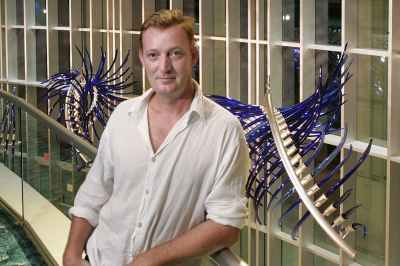 Jonathan Christie, pictured in front of the largest work of his career, a public art collaborative piece entitled Lyrical Light (2006) at the Times-Union Center for the Performing Arts in Jacksonville, Florida.
Jonathan Christie, pictured in front of the largest work of his career, a public art collaborative piece entitled Lyrical Light (2006) at the Times-Union Center for the Performing Arts in Jacksonville, Florida.
Jonathan Christie, one of the most skilled hot-glass sculptors in the United States, died on Sunday, July 7, 2013, days after being hospitalized in New Orleans, Louisiana. He was 44 years old. In March 2013, Christie had returned to a city he had known from an earlier stint at New Orleans Glassworks in the early 1990s. Christie often changed location, and since graduating from college in 1992, had lived in Cincinnati; New York City; Seattle; Jacksonville, Florida; and the British Virgin Islands. Born in Scotland in 1968, he was 12 when he moved to the U.S. with his parents, and attended schools in New Canaan, Connecticut, and Londonderry, New Hampshire. It was at the Massachusetts College of Art where he discovered glass, and forged a life-long friendship with James Mongrain, a fellow glass major.
 An undated Facebook photo of the late Jonathan Christie and James Mongrain. The two met at MassArt and remained close friends.
An undated Facebook photo of the late Jonathan Christie and James Mongrain. The two met at MassArt and remained close friends.
“We instantly became friends,” Mongrain told the GLASS Quarterly Hot Sheet in a telephone interview, explaining how the two bonded at a George Thorogood concert in Boston. “I came from Minnesota, Jon was from New Hampshire and was more used to being in the city. I looked to him for city smarts.” The friendship would endure after graduation, and the two both moved to New Orleans, and later collaborated on a two-year lighting project in Cincinnati, during which time the duo would travel to New York to teach at UrbanGlass (the nonprofit art center that publishes the Hot Sheet and GLASS Quarterly). Mongrain and Christie were regular instructors and assistants at Pilchuck, where Christie connected with major contemporary artists using glass including Kiki Smith, for whom he fabricated works in glass on an ongoing basis.
Those who knew him best describe his generosity with his time and knowledge, his willingness to help others, and his sociability and genuine openness to people.
“Jon could talk to anybody about anything,” says Mongrain. “He was always the forefront guy, didn’t matter who it was.”
“He was someone with exceptional manners,” said artist and close friend Tom Farbanish in a telephone interview. “He was Old World in this very different world today of selfishness and self-preservation. It’s such a warped view of what’s valued now. Jon was not like that, he was the first to pitch in, and always happy to help the other guy.”
A New York-based artist who arrived at UrbanGlass fresh out of college remembers Christie’s willingness to hire and teach. “I was lucky enough to work with him as one of his assistants for various jobs that he had, and he was just an incredibly welcoming artist, very gentle and patient,” says Jamie Harris. “And he was one of the most talented American solid sculptors. There aren’t many that can do what can do what Pino Signoretto can do, but Christie could do that.”
 Jonathan Christie and Caroline Madden with Jacksonville University students, Lyrical Light (installation at the Times-Union Center for the Performing Arts, Jacksonville, Floida), (2006).
Jonathan Christie and Caroline Madden with Jacksonville University students, Lyrical Light (installation at the Times-Union Center for the Performing Arts, Jacksonville, Floida), (2006).
Glass and steel. Dimensions variable. courtesy: cultural council of greater jacksonville
Jacksonville University assistant professor of glass art Brian Frus taught alongside Christie at the Florida university, and says his influence continues to affect the glass program. “Jon got students involved in a direct way, finding authentic learning opportunities to engage the students with real world problems and solutions,” Frus said in a telephone interview. Christie would realize the largest work of his career while at Jacksonville as artist-in-residence, completing a complex public art project with his students and Jacksonville former associate professor Caroline Madden. Weighing two tons, and made up of more than 300 individual glass horns, Lyrical Light (2006) is installed at a Jacksonville performing arts center.
In a telephone interview, Christie’s father, David, said that the monumental work showcased some of his son’s unique abilities. “He could visualize things on a massive scale. He designed the entire structure plus the means of suspension, which owed a lot to what he knew about yacht rigging. The engineers reviewing the plans scratched their heads a bit, but when they mocked up a section of the piece and tested it to destruction, they found his design was as good as any engineer could have done.”
Farbanish, an accomplished sailor, compares Christie’s intuitive glass skills with his natural nautical abilities. “I guess glass and sailing have some correlation,” he says. “You know what you need to do to get from A to B in both areas, but there are the little weirdo things the glass does that need to be adjusted for. Sailing is kind of similar, it’s not a firm thing, there are variables that are pulling with one another. A good sailor can digest all this information at the same time because it’s all in flux. You have to figure out what minor adjustments you need to do to get the outcome you desire. Jon understood attention to detail, the dynamics, the effect of weather on objects, course corrections. And I think he did the same with glass.”
 The vessel Jolo II (“Jolo” stands for Jonathan and Lorna, Christie’s sister) leaving Newport headed to Bermuda and then on to the British Virgin Islands under Jon’s command. courtesy: david christie
The vessel Jolo II (“Jolo” stands for Jonathan and Lorna, Christie’s sister) leaving Newport headed to Bermuda and then on to the British Virgin Islands under Jon’s command. courtesy: david christie
Christie worked with some of the biggest names in glass, including a stint at Chihuly Studios from 2007 to 2010, where he had the chance to work together with his best friend Mongrain. And yet his personal output is not as large as you might expect. “He could have done so much more, had so much to offer and so much ability, it was just the beginning, it’s so hard to see it come to an end,” says Mongrain.
Christie’s father says that instead of a memorial service, the family plans a “celebration of life,” which will likely take place in Seattle sometime in Fall 2013, organized in conjunction with Mongrain.
“We just want to focus on the good things,” said the elder Christie. “We’re not going down the conventional route.” The same is true for Jonathan Christie’s ultimate resting place. His father is planning a burial at sea, scattering his ashes in the waters off the British Virgin Islands, where Jonathan spent several years sailing and blowing glass at a small glass studio there.
“Jon was my best friend, and my captain,” his father says, explaining that whenever the two sailed together, he put his son in charge. “He was very confident, mechanically, electrically; he had all the skills needed to keep a boat afloat. He understood all the modern navigational equipment developed since I was a competitive racer in my youth. But he also understood the natural forces of wind. I was always most comfortable when I had him aboard.”
–Andrew Page


